Gdańsk’s mix of history, stunning architecture, and lively nightlife, makes it the perfect city for a weekend getaway. Plus, its location on the northern coast of Poland makes it a great beach destination too. We recently visited for a girls’ weekend away and loved it.
There are really so many brilliant things to do in Gdańsk, you’ll be spoilt for choice. Whether you are heading for a day trip, a weekend city break, or a part of a road-trip in Poland, you’ll have plenty to keep you busy.
In our guide, we’ll share all our suggestions of the top attractions and best things to do in Gdańsk, so you can plan your own trip. If you want help putting the places together, you can take a look at our 2 days in Gdańsk itinerary for some planning ideas.
Let’s go!
*contains affiliate links
Contents: click to jump to a section
Where is Gdansk?
Gdańsk is located in northern Poland, on the southern coast of the Baltic Sea. It is approximately 350 kilometres (217 miles) north of Warsaw, the capital of Poland, and is situated close to other major cities like Gdynia and Sopot, forming the Tricity metropolitan area. This coastal location makes it easy to combine your city break with a trip to the seaside.
Best things to do in Gdansk
Walk along Dluga Street
Dluga Street (or the Royal Way) in the Old Town is an excellent starting point for your visit to Gdańsk. Begin at the Golden Gate, from where you can stroll down the main pedestrian street, lined with colourful merchant houses, cafés, and bars. As one of the busiest areas in the city, it’s always bustling with activity, so be prepared for crowds!
Despite the number of tourists, Dluga Street is still a must-see destination in Gdańsk, as it is so picturesque. While many of the original buildings were tragically destroyed during WWII, but they have been meticulously restored and painted to capture the original appearance. The street flows into Dlugi Targ, the old market place.
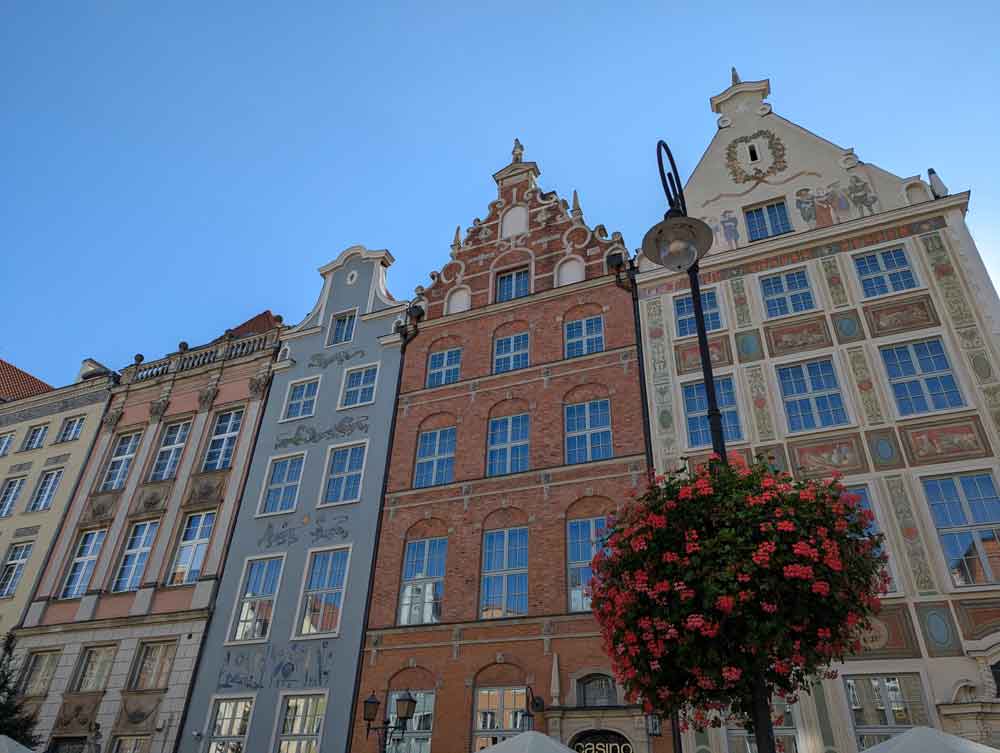
Nowadays, Dluga Street is still home to some of Gdańsk’s most important historic buildings. Although it’s only 500 metres long, there are plenty of top attractions to see. Keep a look out for:
Artus Court: This pale blue Gothic building, once a meeting place for merchants, now houses the Gdańsk Museum.
Gdańsk’s Town Hall: It has an impressive Gothic-Renaissance design and is home to the Historical Museum of Gdańsk.
Golden House: Built in 1618, the Golden House is one of the most ornate building in the Royal Way.
Neptune's Fountain
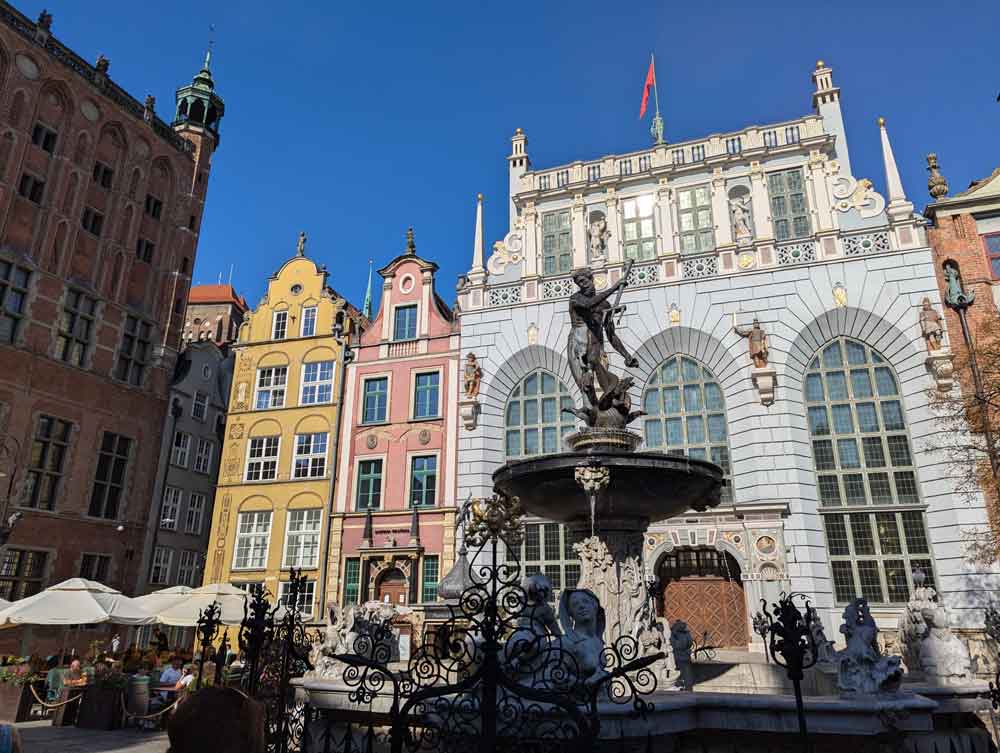
One of the top attractions in Dluga Street is the iconic 17th century Neptune’s Fountain.
Situated in front of Artus Court, this impressive bronze statue of the sea god, Neptune symbolises Gdańsk’s maritime heritage. It is the main centrepiece of Dluga Street and one of the most popular photo spots in Gdańsk.
Prison Tower and Torture Chamber
For a fascinating look into Gdańsk’s medieval past, the Torture Museum is located in a former prison tower at the top of Dluga Street. With its gruesome collection of historic torture devices, the museum offers an intriguing insight into the judicial practices of medieval Europe.
Motlawa River Embankment (Dlugie Pobrzeze)
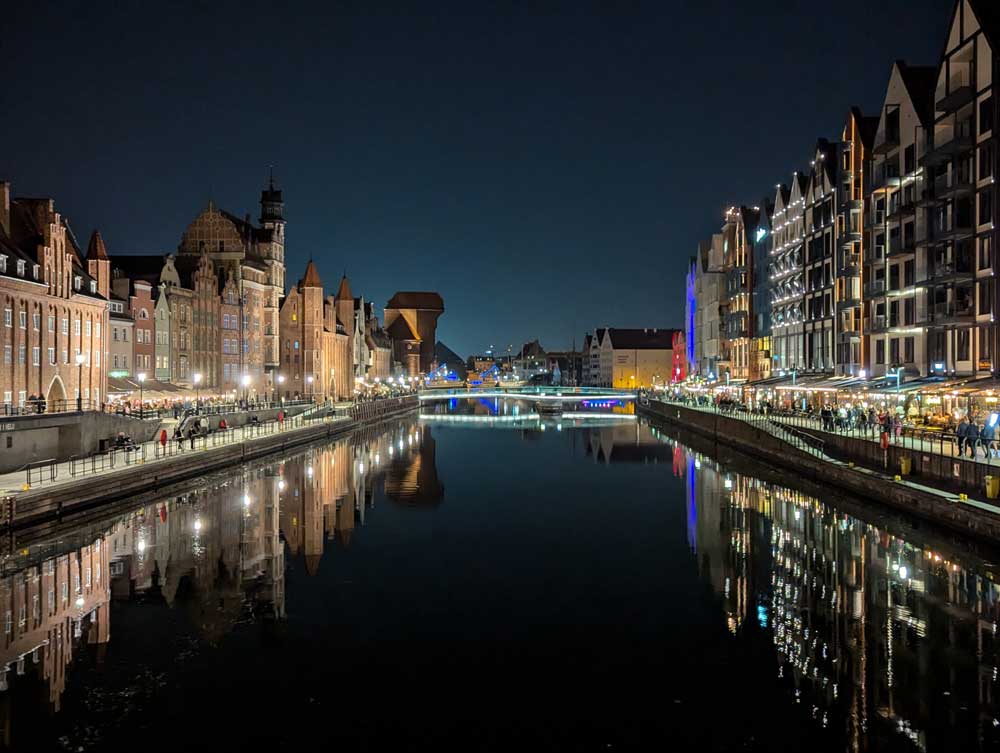
One of the prettiest areas for a stroll in Gdańsk is along the Motlawa River Embankment, especially in the evening. You can also hire boats from this area to explore the river or take a trip to Westerplatte Monument.
One side of the embankment is lined with historic houses and buildings, including the iconic Gdańsk Crane. Whilst you’re on this side of the river, stop at the Kaiser Café for the most delicious patisseries, or the stylish Goldwasser Restaurant for fine dining.
We opted for lunch in Goldwasser, mostly so we could try the famous Goldwasser liqueur. Known for its distinctive gold flakes, this vodka-based drink is one of the top drinks to try in Gdańsk!
The Gdańsk Crane (Żuraw Crane)
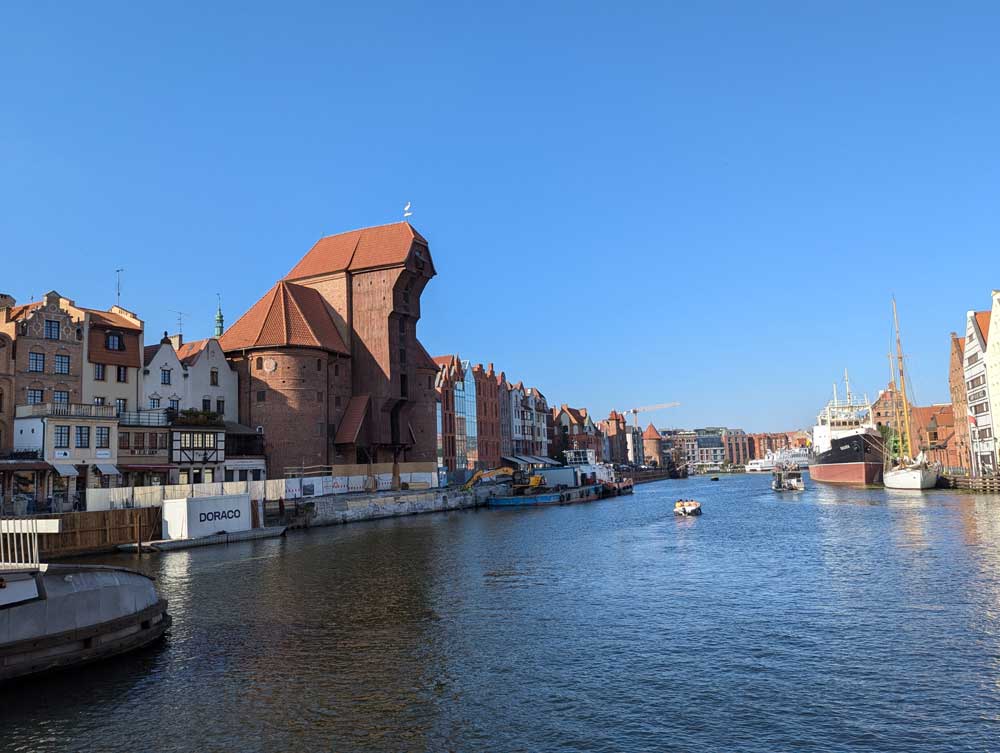
One of the most unusual buildings on the Motlawa riverfront is the Gdańsk Crane, another reminder of the city’s days as a busy trade port. The Crane in Gdańsk is a prime example of a medieval port crane, originally used to lift cargo onto the ships.
The Crane is also the only surviving twin-tower gate in Gdańsk. It belongs to a collection of National Maritime Museums in Gdansk, which includes the Granaries, and Culture Centre. The Gdańsk Crane is open to visitors on Tuesdays, Thursday-Sunday 9am-5pm, and on Wednesday afternoons.
Granary Island
One of the best areas for food and nightlife in Gdańsk is on Granary Island.
To get to Granary Island, cross the Green Bridge at the bottom of the Dlugi Targ. If you’re going in the evening, stop on the bridge for a look at the buildings reflected in the water.
In the 16th century, this island was the main trade centre in Gdańsk and a major source of wealth for the city. It hosted over 300 granary houses, where wealthy merchants stored their grain.
Today, Granary Island has been beautifully revitalised into a vibrant, modern area, featuring many riverside bars and restaurants. It’s the culinary heart of Gdansk and has a laid-back, trendy vibe.
There’s plenty of casual dining areas, including the Słony Spichlerz foodhall, which has a diverse choice of cuisines from around the world. It’s a great place to go with friends, as the food hall has eleven restaurants under one roof.
The Amber Sky
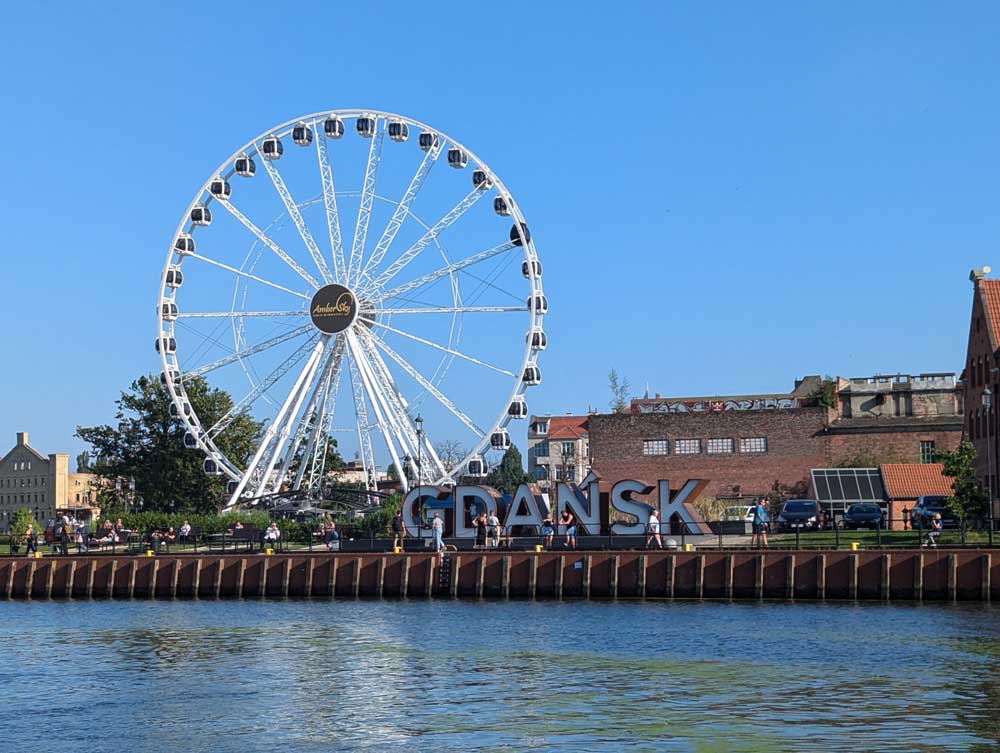
The Amber Sky Ferris Wheel offers panoramic views of Gdańsk’s Old Town and riverfront.
Located at the far end of the islands, near the big Gdańsk sign, it looks especially beautiful at night when it’s lit up.
Westerplatte
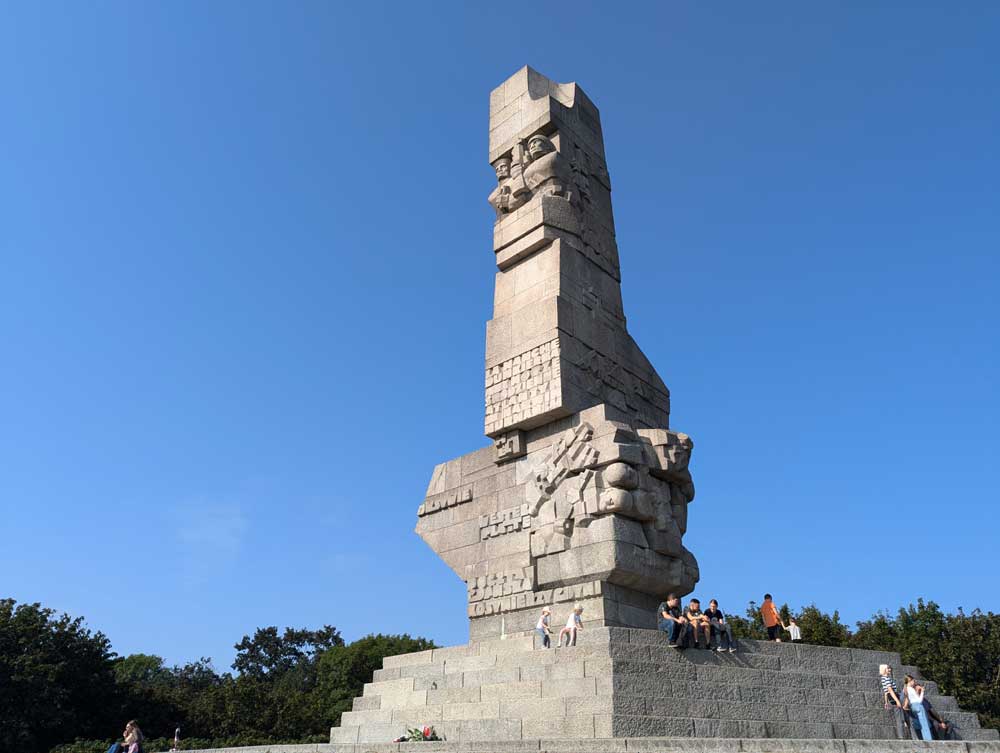
A boat ride from Gdańsk’s city centre transports you to Westerplatte, the historic peninsula where the first battle of WWII took place in 1939.
The journey from the river embankment (near the Hilton Hotel) takes 40 minutes, with views of Gdańsk’s shipyards on the way.
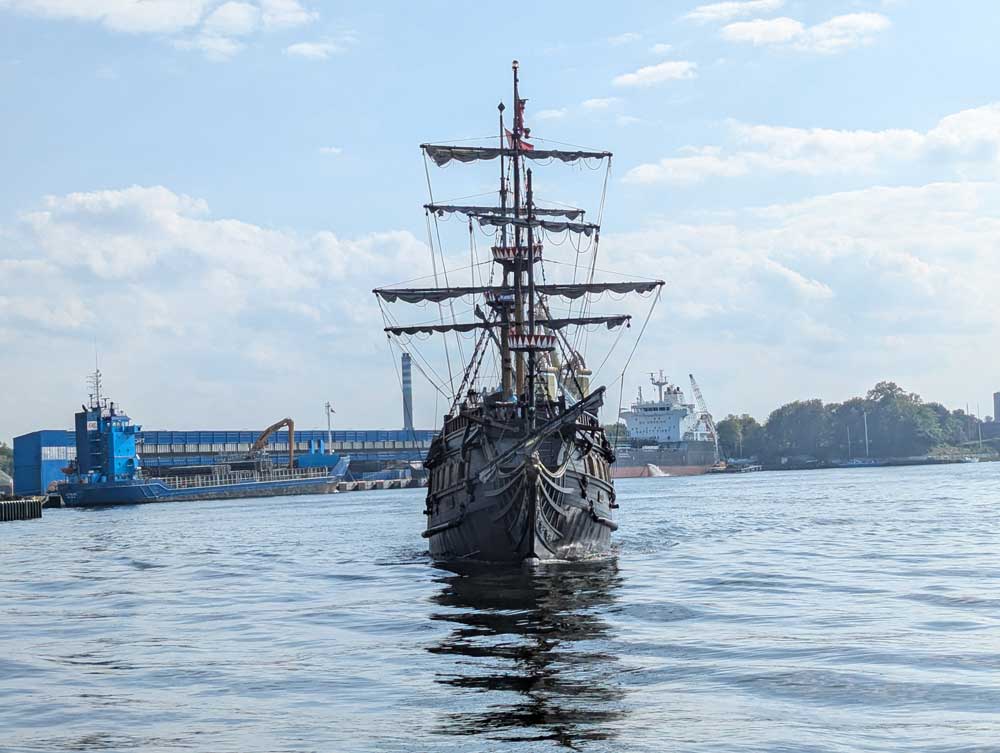
We booked a trip on a pirate boat, which had a commentary and live pirate music, which was fun. However, more conventional means of transport are available if you don’t fancy a Polish sea shanty!
On arrival, it’s a short walk to the enormous Westerplatte Monument, which serves as a tribute to the fallen soldiers. You can also see remnants of bunkers and memorials with the story of the Polish defenders. There is a beach on the peninsular, so you couldn’t stay for longer if you want a day out.
I’d recommend a visit to Westerplatte as one of the best things to do in Gdańsk. Although we didn’t spent very long there, it is of significant historical importance to the Polish people.
Mariacka Street
With its charming cobblestones, elegant Gothic architecuture, and artisan shops, Mariacka Street really is one of the most charming spots in Gdansk. It felt like we were stepping back in time!
To add to its allure, Gargoyle heads, known as Pukers, stick out into the street and spit water when it’s raining.
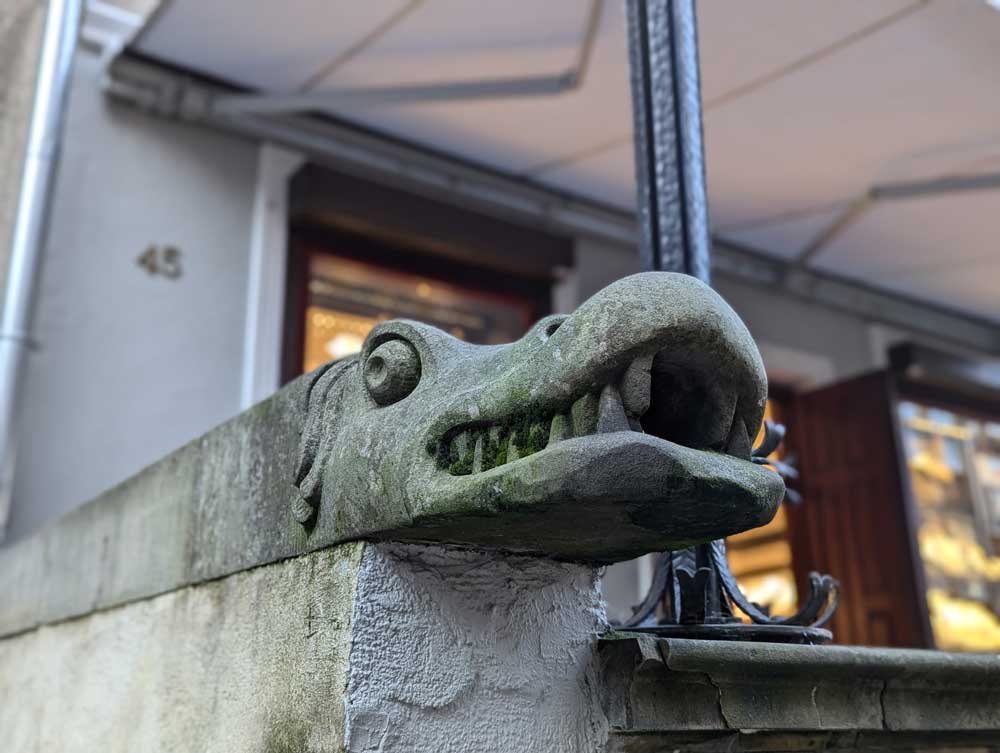
Another attraction at Mariacka Street are the amber galleries and stalls. Known as the Amber Capital of the World, Gdańsk is the perfect place to shop for amber jewellery and Mariacka Street is perfect for browsing.
Often known as “Baltic Gold,” Baltic Amber is formed over millions of years by compressed tree resin, which washes up on the beaches of Gdańsk. If you are interested in craft, you could also visit the Amber Museum.
For a fantastic dining experience, I’d highly recommend Literacka Restaurant and wine bar, located besides the church at the end of Mariacka Street.
St Mary’s Church (Bazylika Mariacka)
At the end of Mariacka Street is an enormous red Gothic building, St. Mary’s Church. It’s considered the largest brick church in the world, so you won’t miss it. It really is gigantic!
Admission to St Mary’s Church is free, so you can pop inside to see the striking 15th century astrological clock, stained-glass windows, and 300 gravestones in the floor.
Whilst you are there, climb the 400 steps of the belltower for a panoramic view of Gdańsk’s red-roofed buildings.
Try some traditional Polish vodka
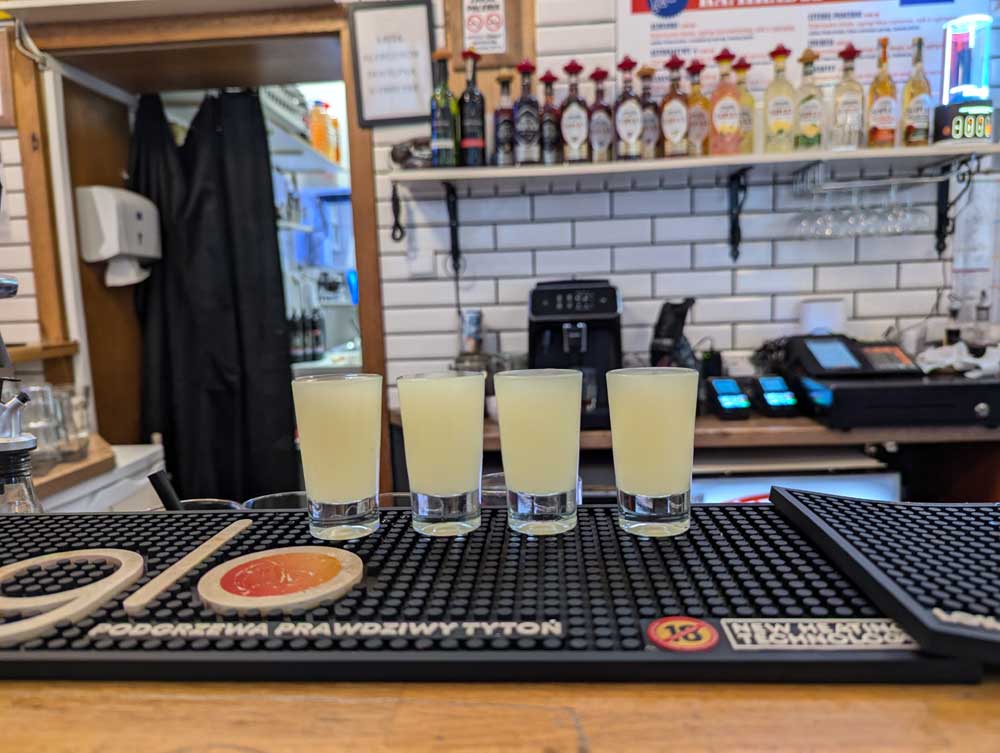
Of course, you can’t visit Gdańsk without trying some traditional Polish vodka! We stopped by one of the local vodka bars, where they have a whole host of different flavours and it’s super cheap.
Sopot Beach
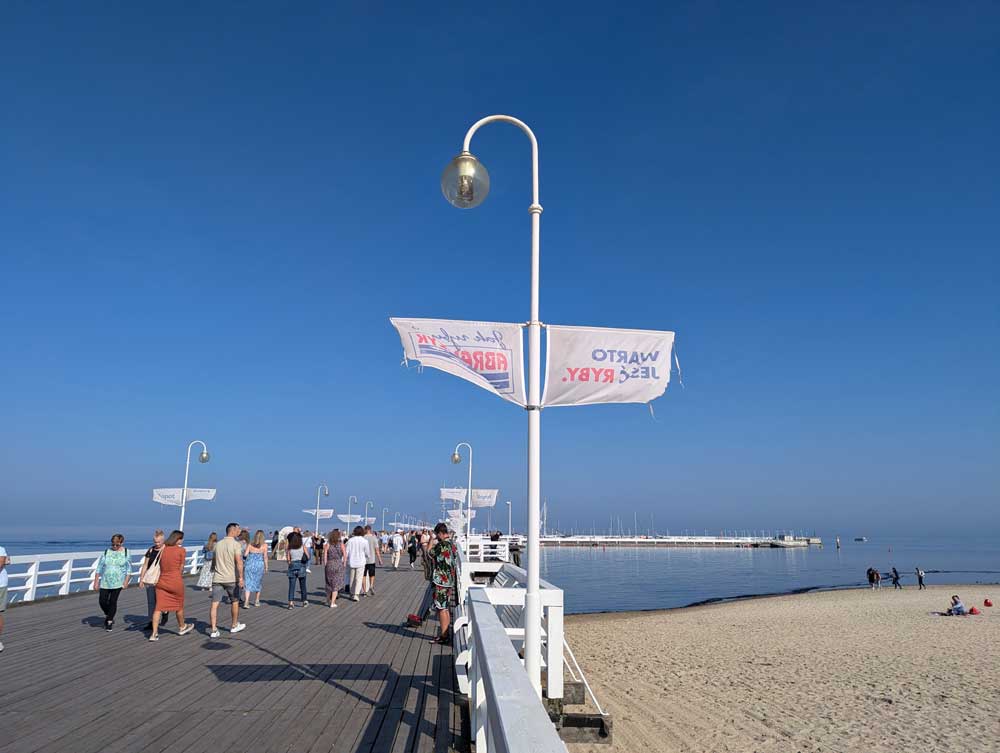
One of the highlights of a city break in Gdańsk is the chance to enjoy the nearby beaches. As part of Poland’s Tri-city area with the coastal towns of Sopot and Gyndnia, Gdańsk offers easy access to the beach.
We took a short train ride to Sopot, a lively coastal town, with the longest wooden pier in Europe. Even in September, it was warm enough to enjoy lunch by the pier, stroll around the harbour, and dip our toes in the Baltic Sea. There are plenty of lively bars and restaurants, so you could stay for an evening out too.
Whilst you’re there, keep a look out for Sopot’s quirky crooked house (Krzywy Domek). It makes a fun photo, or you can go inside to the shops and restaurants.
Museum of the Second World War
The Museum of the Second World War is one of the most popular tourist attractions in Gdańsk. It uses a range of multimedia displays and exhibits to describe the events leading up to the war and its impact on Poland and is people. It’s an interactive experience that will interest everyone, whether or not a history-lover.
The impressive design of the building, partly below ground, creates a powerful setting for the museum.
Practical information: The museum is closed on Mondays.
The European Solidarity Centre
Another of the most popular museums in Gdańsk is The European Solidarity Centre. This modern museum is dedicated to Poland’s historic Solidarity movement, which began in Gdańsk and led to the fall of communism. With interactive exhibits, multimedia displays, and artefacts, this museum highlights Poland’s fight for freedom and is a must for any history-lovers.
Useful information for your visit to Gdansk
Accommodation in Gdansk
- Luxury Accommodation: Radison Blu Hotel is a luxury, 5-star hotel in the centre of Gdansk
- Mid-budget Accommodation: Gotyk House is located in a stunning old building, in the heart of Gdansk.
- Budget Accommodation: Liberum Residence has an excellent location in Dluga Street
Eating and Drinking in Gdansk
Gdańsk’s cuisine is a delightful blend of Polish, German, and Baltic flavours. One of the foods you must try is Pierogi, traditional Polish dumplings filled with meats or cheese. We sampled these at Restauracja Bazar, which has an extensive choice of Polish cuisine.
If you’re on a budget, you could try one of the Milk Bars (bar mleczny), an old-style café, serving very traditional food at super cheap prices. There’s several Milk Bars in Gdańsk, including Neptun Bar on Dluga Street.
Currency in Poland
The local currency in Poland is the zloty. However, we didn’t take any cash, as you can use your credit card everywhere.
How long do you need in Gdansk?
Gdańsk is perfect for a weekend getaway. Although, you could see most of the Old City in one day, I would recommend staying two or three days. This would give you time to get to the beach, take a boat to Westerplatte, or visit a few museums.
Getting around in Gdansk
Gdańsk is easy to explore by foot. However, if you want to venture further afield, you can take a bus, train or taxi. It is only 20 minutes on the train to Sopot. There are also boats, if you want to explore the river.
You may prefer to book a Gdańsk City Walking Tour with a local tour guide, who can help you discover more about the history of the city.
A map of Gdansk
Here is a map of Gdańsk, with all the best attractions, things to do and places to eat. You can use this when planning your own itinerary.
To save the map to Google Maps on your phone or computer, click on the star next to the title. Once you do this, you’ll be able to find the map in your “saved maps” list on your phone.
To see a list of all the items on the map, click the box with arrow on the left. To enlarge the map, click the box on the right.
Pin for later or share with a friend who’d love to go: Best things to do in Gdansk, Poland
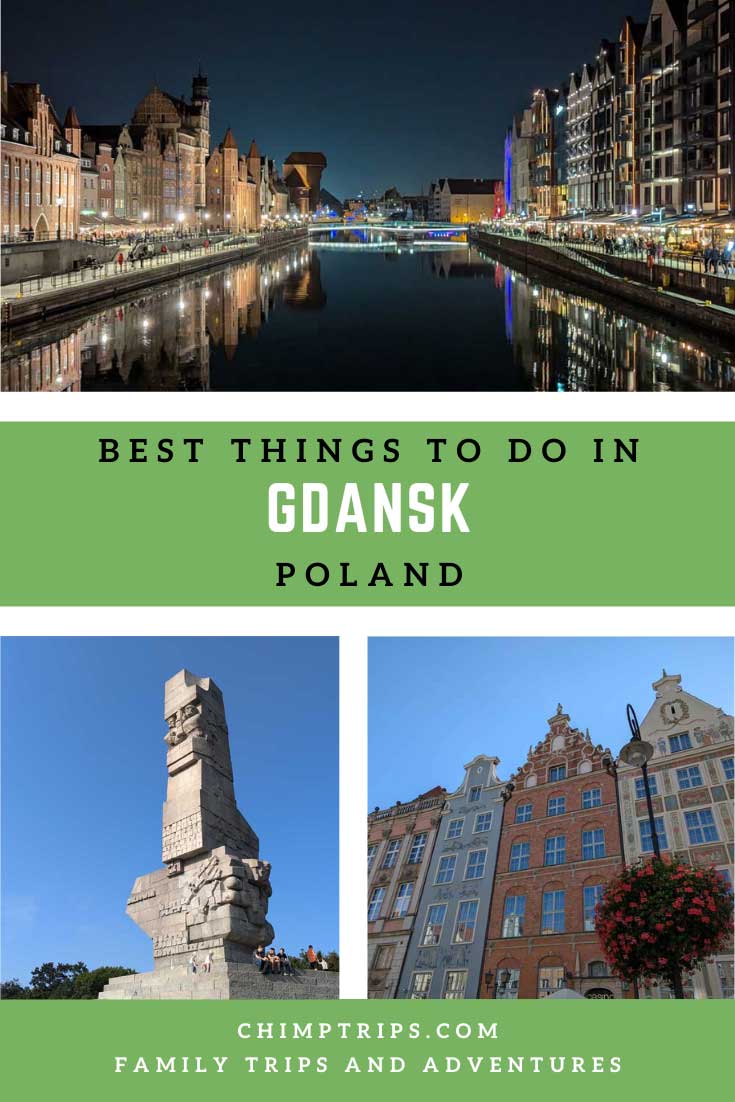
*Disclaimer: This post contains affiliate links – any purchases you make are unaffected but I may receive a small commission. (Read our full Disclosure Policy)
All rights reserved © Chimptrips. Republishing this article and/or any of its contents (text, photography, links, etc.), in whole or in part, is strictly prohibited.
